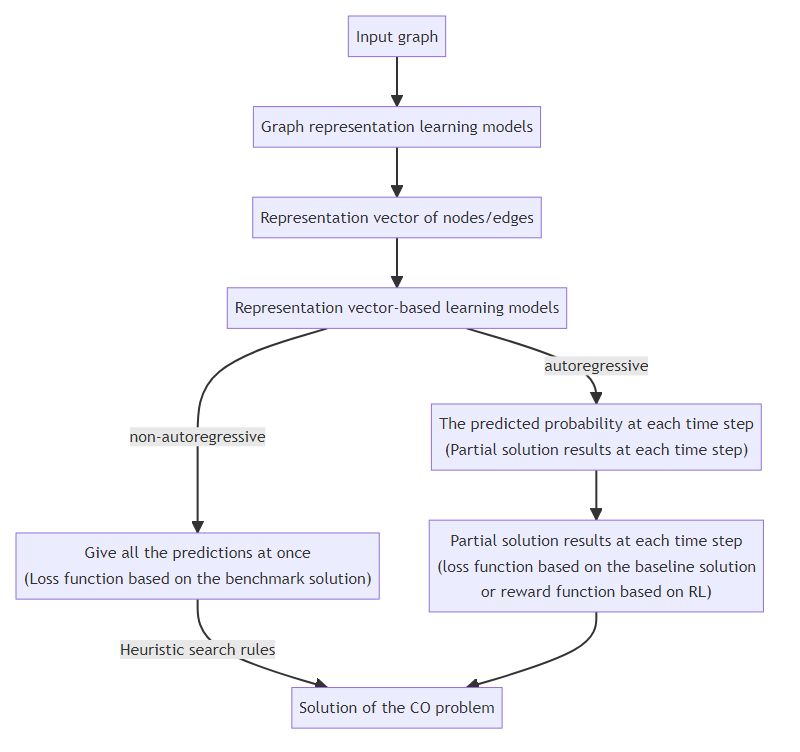Machine learning solution of combinatorial optimization problems
Published:
Notes from a lecture conference, introduced some progress of machine learning solving combinatorial optimization problems, especially combinatorial optimization problems on graphs, including autoregression-based methods and non-autoregression-based methods.
Machine learning solution of combinatorial optimization problems 1
CO and ML4CO
Combinatorial optimization
Combinatorial optimization is to find the optimal arrangement, grouping, order or screening of discrete events through the study of mathematical methods. The problem can be described mathematically as:
\[min \quad f(x) \\ s.t. \quad g(x) \geq 0 \\ \qquad\quad x \in D\]Where $D$ is a set of finite points (the domain), $f$ is the objective function, and \(F= \{ x \ \vert \ x \in D, \ g(x) \geq 0 \}\) is the feasible region.
0-1 knapsack problem, traveling salesman problem, minimum vertex cover problem, maximum cut problem and so on.
Machine learning for combinatorial optimization
Optimization algorithms
- Mathematical Optimization algorithms - Exact algorithms (Exponential time)
- Branch and bound, Branch and price, Branch and cut, Cutting plane, Lagrangian relaxation
- Heuristic algorithms (Polynomial time)
- Approximation algorithm, Greedy algorithm, Rule-based construction algorithm
- Meta heuristic algorithms (Polynomial time)
- Genetic algorithm, Ant colony algorithm, Tabu search, Simulated annealing
- Machine learning methods (Polynomial time)
- Supervised learning, Reinforcement learning, Graph neural networks
Combinatorial Optimization Solvers
- Commercial Solvers
- Gurobi, CPLEX, Matlab, Lingo, CMIP
- Open Source Solvers
- SCIP, LP_Solve, CBC, GLPK, MOSEK
Past and Now
- Traditional solvers: Moderate scale, relatively stable, classical problem, theoretical guarantee
- Machine learning: Super large scale, real-time change, complex system, weak optimization
Machine learning paradigms for solving CO problems
- End-to-end solver $\rightarrow$ autoregressive/non-autoregressive $\rightarrow$ Learning heuristics
- Local improvement solution $\rightarrow$ ML + Traditional operations algorithm $\rightarrow$ Improving OR Solvers
Combinatorial optimization problem solving on the graph

Non-autoregressive algorithms
- Supervised learning + Tree search + Graph theory tricks
- Li Z, Chen Q, Koltun V. Combinatorial optimization with graph convolutional networks and guided tree search[J]. Advances in neural information processing systems, 2018, 31.
Autoregressive algorithms
- S2V - DQN
- Khalil E, Dai H, Zhang Y, et al. Learning combinatorial optimization algorithms over graphs[J]. Advances in neural information processing systems, 2017, 30.
- FINDER
- Fan C, Zeng L, Sun Y, et al. Finding key players in complex networks through deep reinforcement learning[J]. Nature machine intelligence, 2020, 2(6): 317-324.
- DIRAC
- Fan C, Shen M, Nussinov Z, et al. Searching for spin glass ground states through deep reinforcement learning[J]. Nature Communications, 2023, 14(1): 725.
- Lucas A. Ising formulations of many NP problems[J]. Frontiers in physics, 2014, 2: 5.
- Barrett T, Clements W, Foerster J, et al. Exploratory combinatorial optimization with reinforcement learning[C]//Proceedings of the AAAI conference on artificial intelligence. 2020, 34(04): 3243-3250.
- Yao F, Cai R, Wang H. Reversible action design for combinatorial optimization with reinforcement learning[J]. arXiv preprint arXiv:2102.07210, 2021.
Summary of autoregressive algorithms
Graph Representation Learning + Reinforcement Learning
- Pros
- The model generalizes well
- The model works well
- It has some interpretability
- Cons
- Model design and learning are difficult
- Implementation is difficult
Some interesting research points
- How to combine with exact algorithms?
- Nair V, Bartunov S, Gimeno F, et al. Solving mixed integer programs using neural networks[J]. arXiv preprint arXiv:2012.13349, 2020.
- How to combine with heuristics?
- Mills K, Ronagh P, Tamblyn I. Finding the ground state of spin Hamiltonians with reinforcement learning[J]. Nature Machine Intelligence, 2020, 2(9): 509-517.
- How to improve generalization on large instances?
- Fu Z H, Qiu K B, Zha H. Generalize a small pre-trained model to arbitrarily large TSP instances[C]//Proceedings of the AAAI conference on artificial intelligence. 2021, 35(8): 7474-7482.
- How do you handle complex constraints?
- Donti P L, Rolnick D, Kolter J Z. DC3: A learning method for optimization with hard constraints[J]. arXiv preprint arXiv:2104.12225, 2021.
- How to combine with mature solvers?
- Pogančić M V, Paulus A, Musil V, et al. Differentiation of blackbox combinatorial solvers[C]//International Conference on Learning Representations. 2019.
- How do you handle raw inputs that are more natural?
- ChatGPT understands natural language problem requirements, models them automatically, and invokes a solver to solve them.
